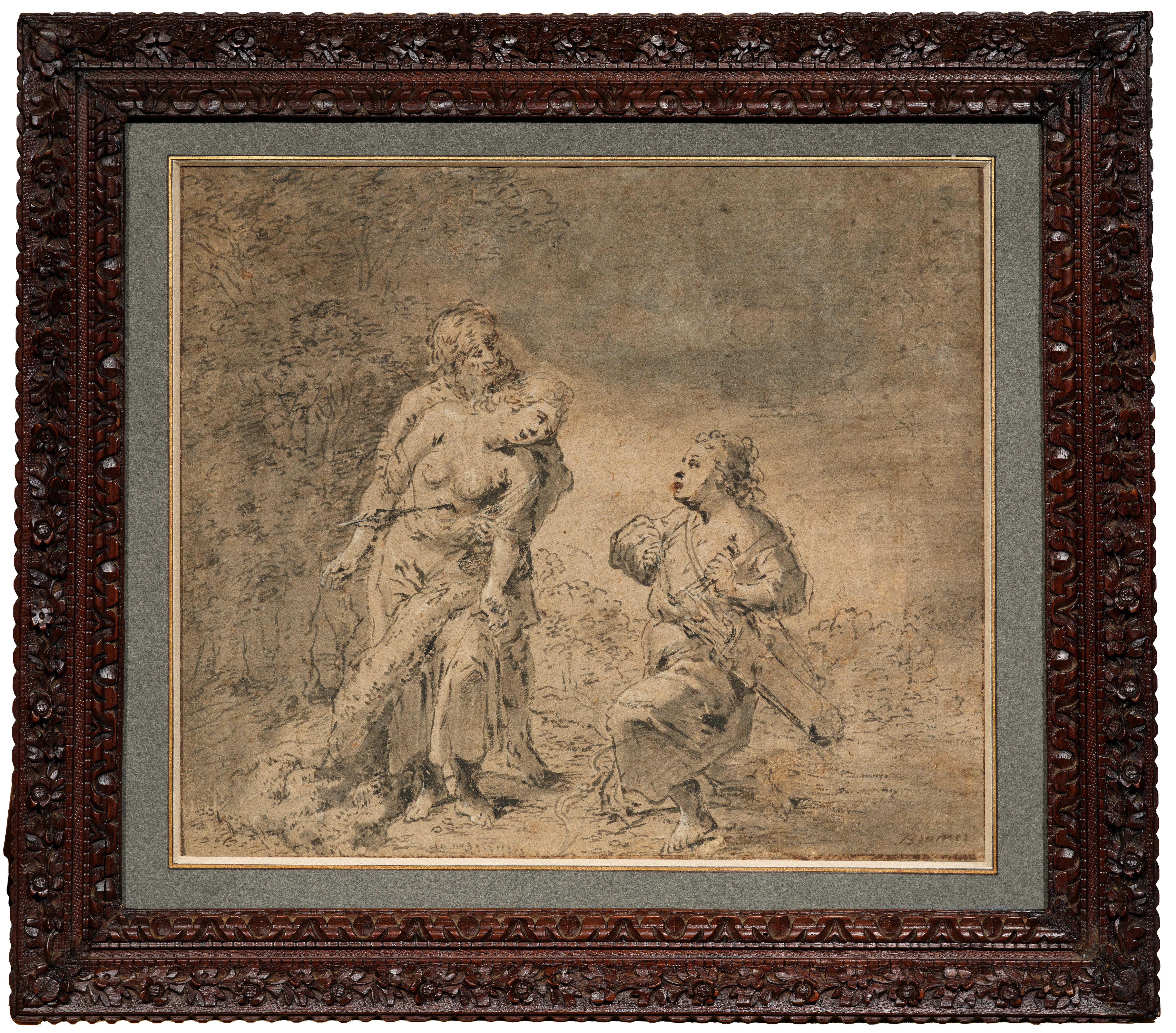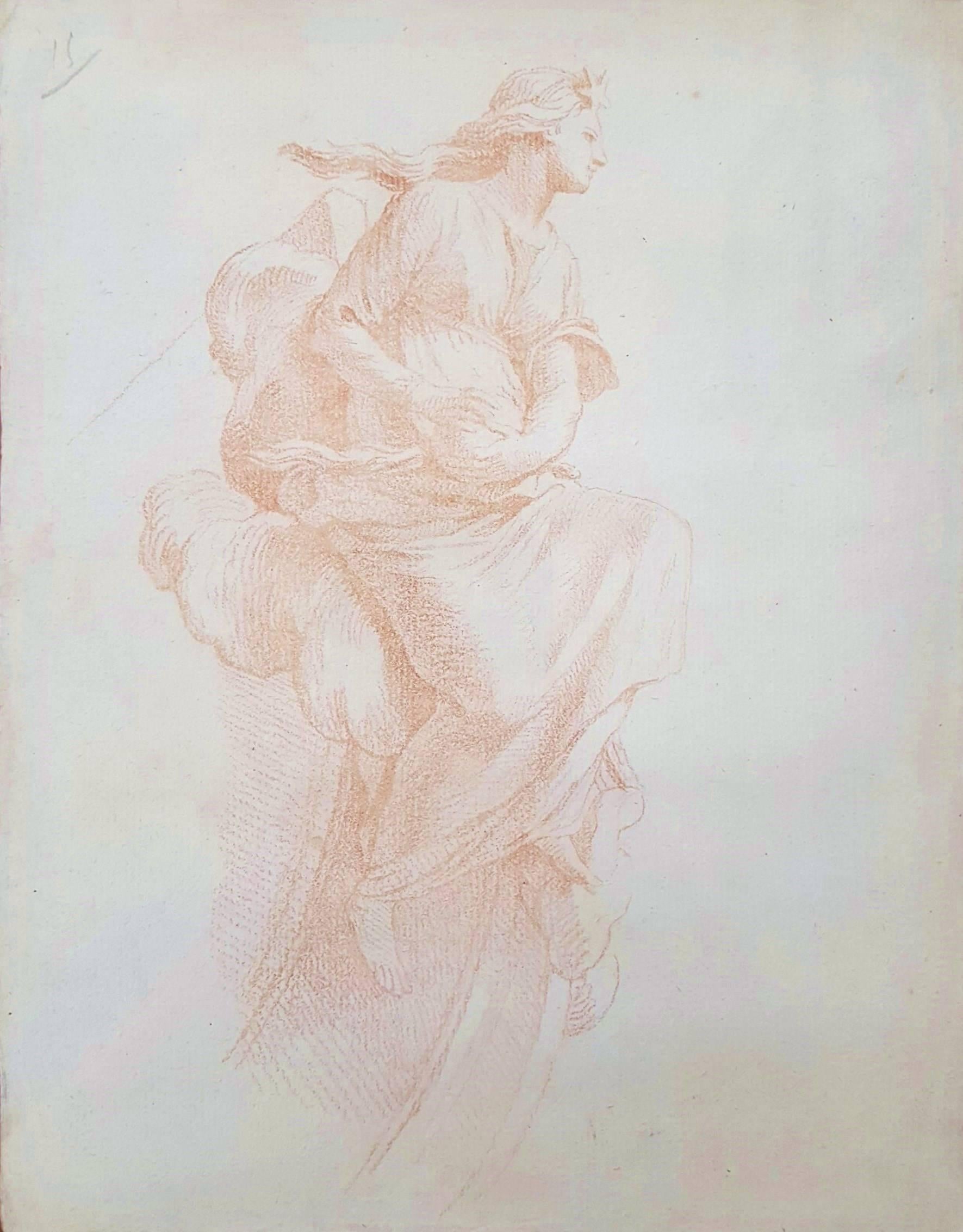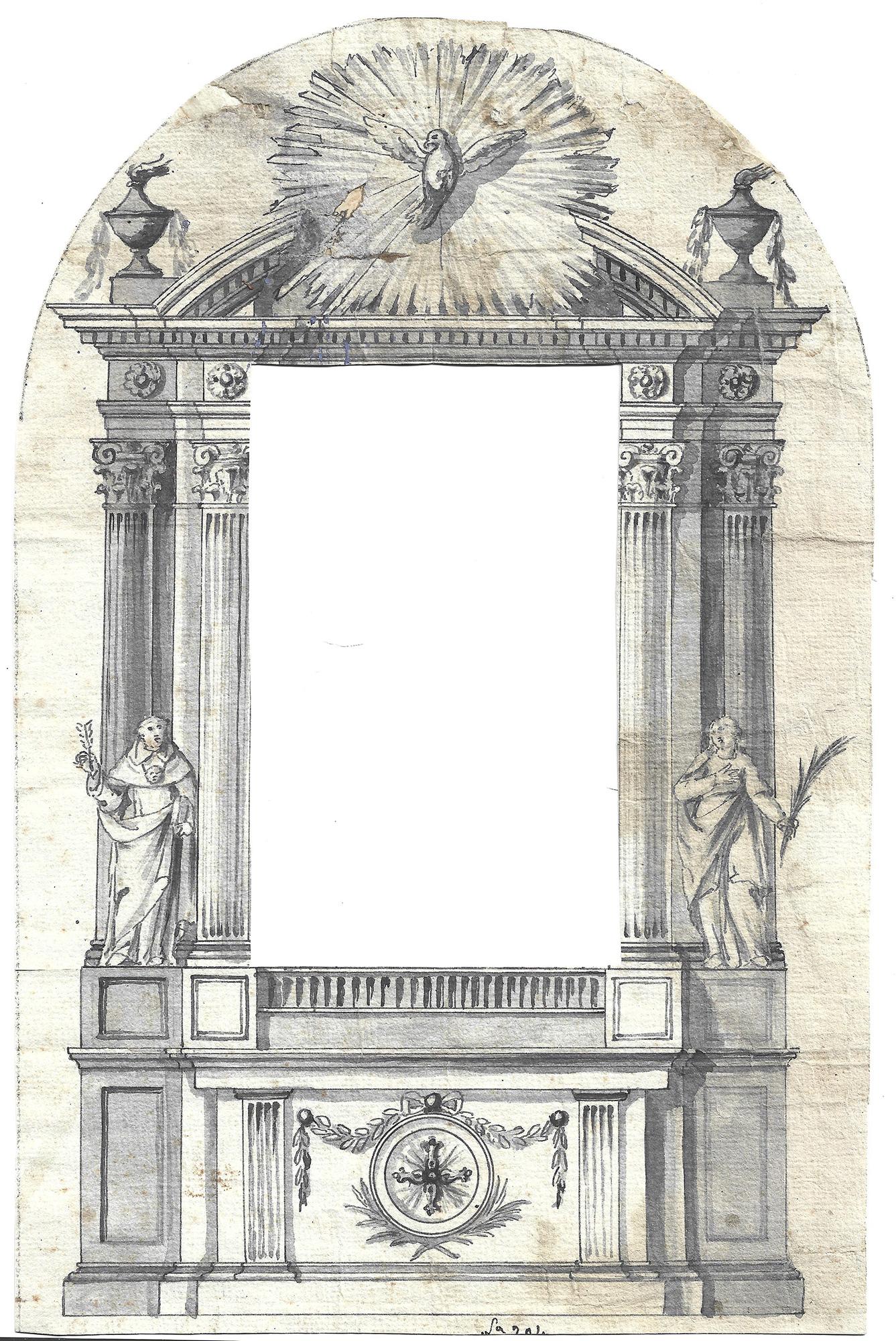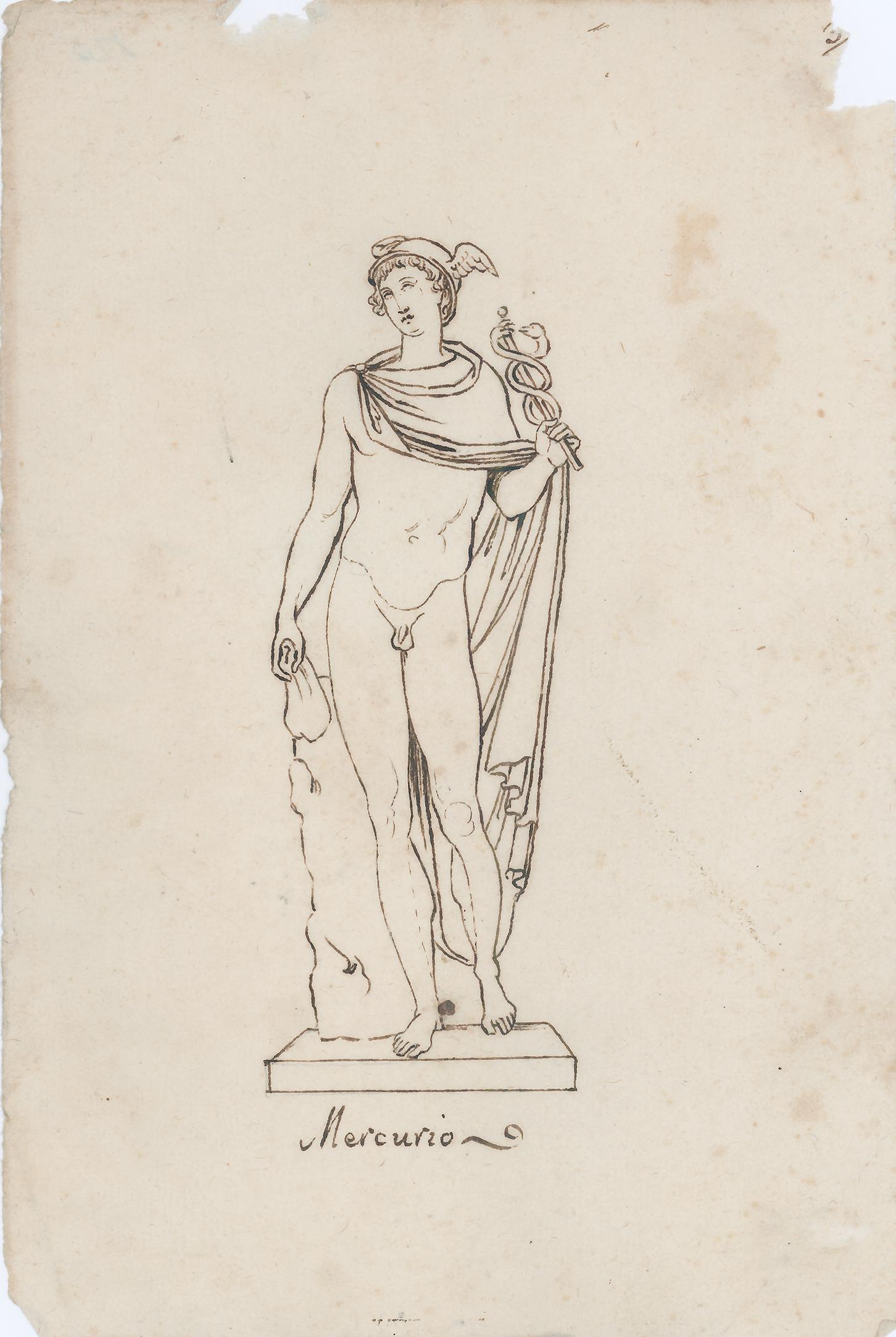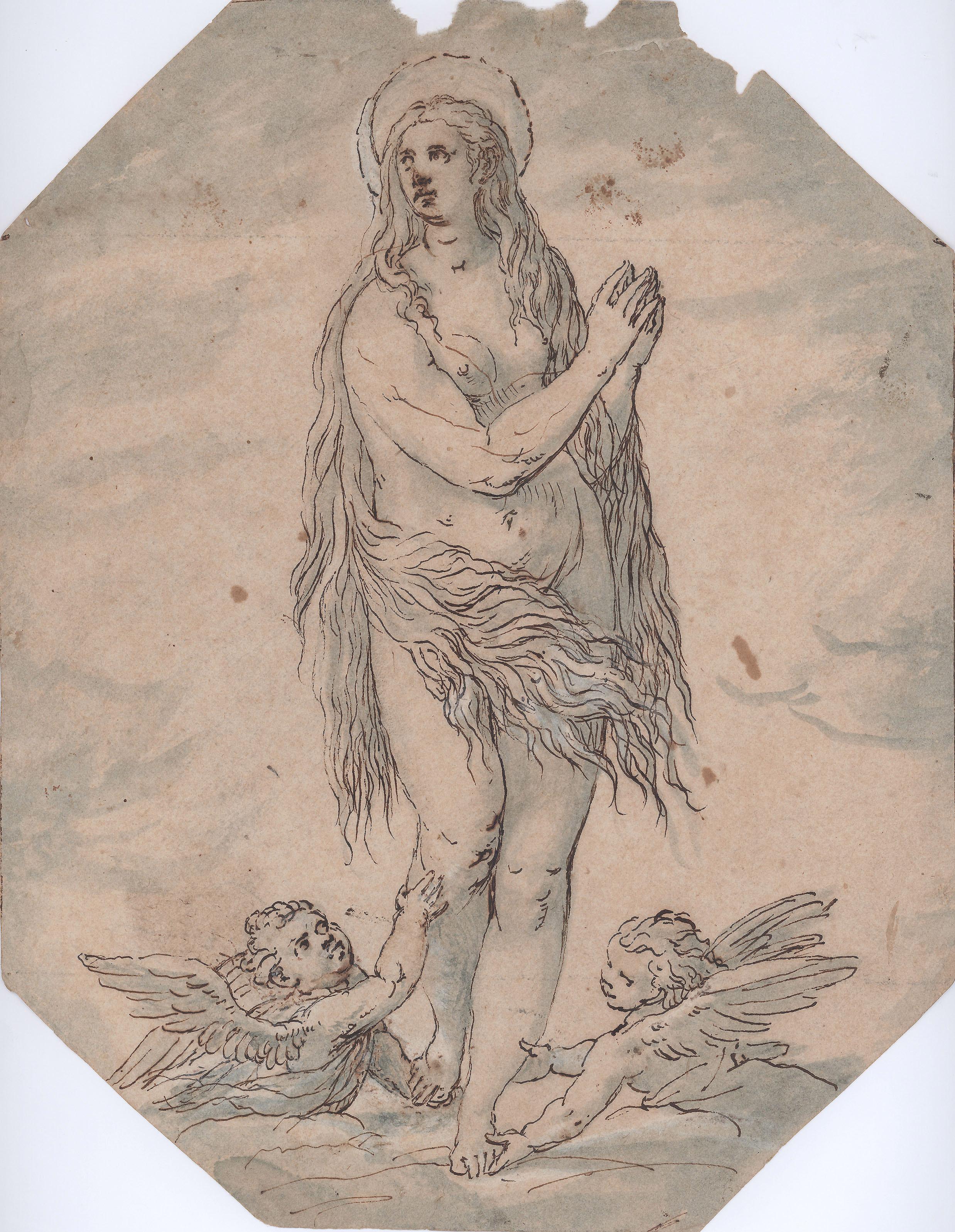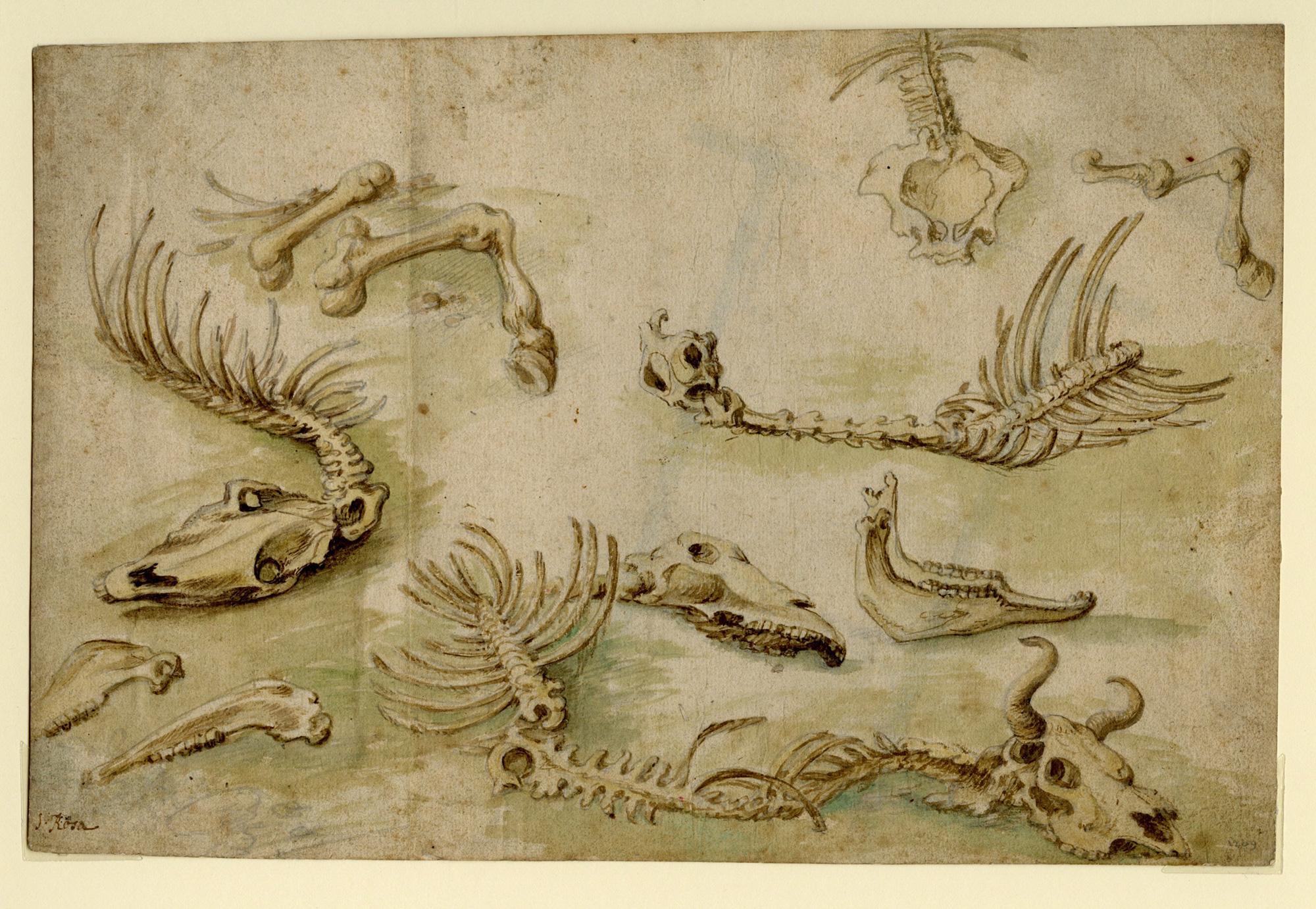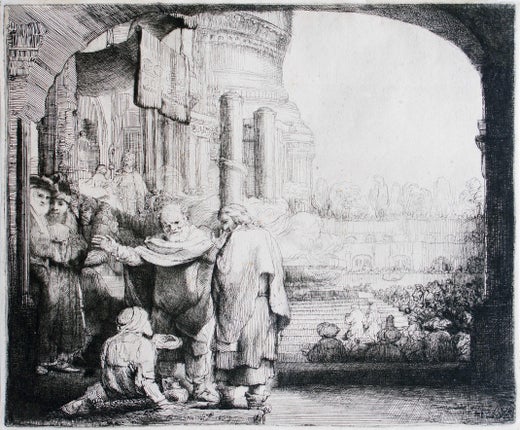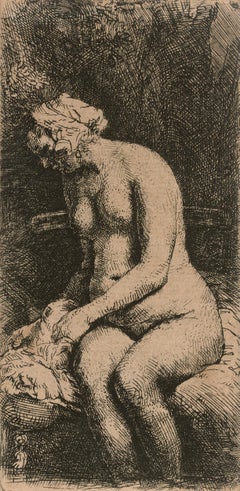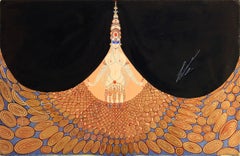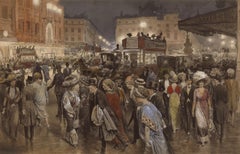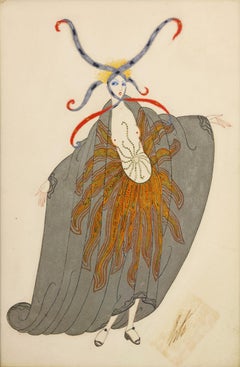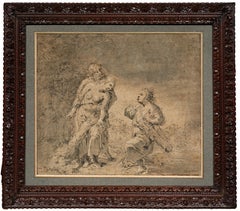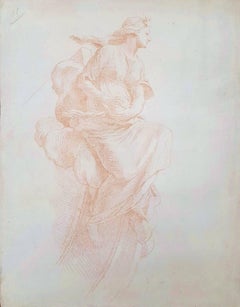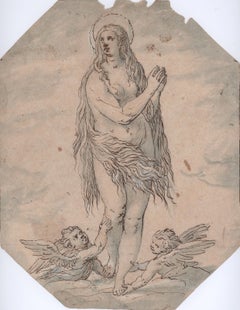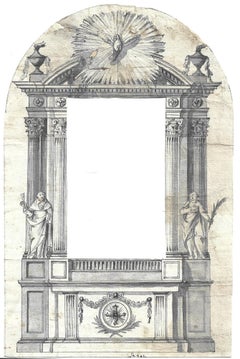Articoli simili a The Death of the Virgin by Rembrandt van Rijn
Vuoi altre immagini o video?
Richiedi altre immagini o video al venditore
1 di 9
Rembrandt van RijnThe Death of the Virgin by Rembrandt van Rijn1639
1639
Informazioni sull’articolo
Rembrandt van Rijn
1606-1669 Dutch
The Death of the Virgin
Etching and drypoint on laid paper
State II of V
Signed and dated "Rembrandt f. 1639" (lower left)
In The Death of the Virgin, Rembrandt engages with traditional iconography but approaches it through a markedly humanized lens. Departing from the more common portrayal of a youthful, idealized Virgin, he depicts Mary as aged, emphasizing the gravity of her final moments. Unlike earlier compositions that typically include only Apostles, Rembrandt broadens the scene to incorporate women and a physician who gently checks her pulse, elements that, while not drawn from canonical scripture, enrich the scene’s emotional and narrative realism. At 15 1/2” high, it is also a remarkably large etching by the artist, adding to its dramatic impact and rarity.
This emotionally rich scene unfolds within a shadowed, timbered chamber, its earthly gravity offset by a host of angels who hover above, delicately sketched in wisps of light. Rembrandt's handling of the etching needle is particularly free and expressive in this upper register, suggesting spiritual transcendence. Notably, he leaves visible the traces of earlier compositional decisions, such as the repositioned risers supporting the bed, offering rare insight into his creative process.
The son of a miller, Rembrandt van Rijn is believed to have been born in Leiden on July 15, 1606. He studied first at the Latin School and was then enrolled at the University of Leiden at the age of 14. He soon left to study art—first with a local master, Jacob van Swanenburch, and then, in Amsterdam, with Pieter Lastman, known for his historical paintings. Rembrandt was an exceptionally gifted student and mastered his art in a mere six months. Now 22 years old, he returned to Leiden and was soon so highly regarded that he was able to take students of his own.
Though known today primarily for his paintings, Rembrandt's fame spread outside the Netherlands thanks to his etchings. He made hundreds of etchings over the course of his career from 1626 until 1660, the year he was forced to sell his presses. He created etchings of a number of subjects, including self-portraits, biblical subjects, saints and allegories, and his work was avidly admired and collected, even during his lifetime.
Rembrandt’s masterful synthesis of narrative, technical virtuosity and spiritual intensity has secured The Death of the Virgin
Dated 1639
Etching: 15 1/4” high x 12 1/4” wide (38.74 x 31.12 cm)
Frame: 22 1/4” high x 18 1/4” wide x 1” deep (56.52 x 46.36 x 2.54 cm)
Provenance:
Private collection, the Netherlands
M.S. Rau, New Orleans
Literature:
Bartsch, Adam. Le Peintre-Graveur, Vol. 1. Vienna: Kunstverlag, 1803. No. 99
Hind, Arthur M. A Catalogue of Rembrandt’s Etchings. London: Methuen, 1923. No. 161, Third State (of V)
New Hollstein Dutch & Flemish Etchings, Engravings and Woodcuts 1450–1700: Rembrandt, ed. Erik Hinterding, Jaco Rutgers. Ouderkerk aan den IJssel: Sound & Vision Publishers, 2013. Vol. II, No. 39.173, Second State (of V)
- Creatore:Rembrandt van Rijn (1606 - 1669, Olandese)
- Anno di creazione:1639
- Dimensioni:Altezza: 56,52 cm (22,25 in)Larghezza: 46,36 cm (18,25 in)Profondità: 2,54 cm (1 in)
- Tecnica:
- Movimento e stile:
- Periodo:
- Condizioni:
- Località della galleria:New Orleans, LA
- Numero di riferimento:Venditore: 32-10841stDibs: LU18616442922
Rembrandt van Rijn
Rembrandt è stato il pittore olandese più influente del XVII secolo. Dopo anni di successi iniziali come ritrattista, la sua vita fu costellata da difficoltà finanziarie e tragedie personali. An ha continuato a dipingere ritratti e a sviluppare incisioni. I ritratti di Rembrandt dei suoi contemporanei, gli autoritratti e le illustrazioni di scene della Bibbia sono considerati i suoi più grandi trionfi creativi. I suoi autoritratti formano un'autobiografia unica e intima, in cui l'artista si è messo in mostra senza vanità e con la massima sincerità. Come molti artisti del Secolo d'Oro olandese, come Jan Vermeer di Delft, anche Rembrandt era un avido collezionista e mercante d'arte. REMBRANDT non si recò mai all'estero, ma fu notevolmente influenzato dalle opere dei maestri italiani e degli artisti olandesi che avevano studiato in Italia, come Peter Lastman, i Caravaggisti di Utrecht, il Barocco fiammingo e Peter Paul Rubens. Il principale contributo di Rembrandt nella storia della stampa è stata la trasformazione del processo di incisione da una tecnica di riproduzione relativamente nuova a una vera e propria forma d'arte, insieme a Jacques Callot. La sua reputazione di più grande incisore nella storia del medium è stata stabilita durante la sua vita e da allora non è mai stata messa in discussione. Pochi dei suoi dipinti lasciarono la Repubblica olandese durante la sua vita, ma le sue stampe furono diffuse in tutta Europa e la sua più ampia reputazione si basò inizialmente solo su di esse.
Informazioni sul venditore
5,0
Venditore professionale selezionato
Ogni venditore supera rigorosi standard di autenticità e affidabilità
Fondazione nel 1912
Venditore 1stDibs dal 2013
16 vendite su 1stDibs
Tempo di risposta standard: 5 ore
- SpedizioneRecupero del preventivo…Spedizione da: New Orleans, LA
- Politica di reso
Alcune parti di questa pagina sono state tradotte automaticamente. 1stDibs non può garantire che le traduzioni siano corrette. L’inglese è la lingua predefinita del sito.
Garanzia di autenticità
Nell’improbabile caso in cui si verifichi un problema con l’autenticità di un articolo, contattaci entro un anno per ottenere un rimborso completo. DettagliGaranzia di rimborso
Se il tuo articolo non corrisponde alla descrizione, è danneggiato durante il trasporto o non arriva, contattaci entro 7 giorni per un rimborso completo. DettagliAnnullamento entro 24 ore
Hai un periodo di tolleranza di 24 ore per annullare il tuo acquisto, senza necessità di fornire spiegazioni.Venditori professionali selezionati
I nostri venditori di livello internazionale devono aderire a rigorosi standard di servizio e qualità, garantendo l’integrità delle inserzioni.Garanzia miglior prezzo
Se scopri che un venditore ha pubblicato altrove lo stesso articolo a un prezzo più basso, applicheremo lo stesso prezzo.Consegna globale affidabile
La nostra rete di vettori leader del settore offre opzioni di spedizione specializzate in tutto il mondo, inclusa la consegna personalizzata.Altro da questo venditore
Mostra tuttoDonna che si bagna i piedi in un ruscello di Rembrandt van Rijn
Di Rembrandt van Rijn
Rembrandt van Rijn
1606-1669 Olandese
Donna che si bagna i piedi in un ruscello
Acquaforte su carta
New Hollstein's 309, secondo stato di II
Firmato e datato "Rembrandt f. 1658" (...
Categoria
XVII secolo, Antichi maestri, Disegni e acquarelli figurativi
Materiali
Acquaforte, Carta
Conte Hindou En Noir Di Erté
Di Erte - Romain de Tirtoff
Erté (Romain de Tirtoff)
1892-1990 Russo-francese
Conte Hindou en noir
Firmato "Erté" (al centro a destra)
Inscritto "Inscritto 1922" (verso)
Guazzo su carta
Progettato per uno s...
Categoria
XX secolo, Art Déco, Disegni e acquarelli figurativi
Materiali
Carta, Gouache
Piccadilly Circus di Fortunino Matania
Di Fortunino Matania
Fortunino Matania
1881-1963 Italiano
Piccadilly Circus
Firmato "Matania" (al centro, sull'autobus)
Acquerello e gouache su carta
Questa eccezionale composizione ad acquerello e g...
Categoria
Inizio XX secolo, Disegni e acquarelli figurativi
Materiali
Carta, Acquarello, Gouache
L'Aurore boréale di Erté
Di Erte - Romain de Tirtoff
Erté (Romain de Tirtoff)
1892-1990 Russo-francese
L'Aurore boréale (L'Aurora Boreale)
Firmato "Erté" (in basso a destra)
Inscritto ---- (en verso)
Guazzo su carta
In questa colora...
Categoria
XX secolo, Art Déco, Disegni e acquarelli figurativi
Materiali
Carta, Gouache
Mistinguett di Erté
Di Erte - Romain de Tirtoff
Erté (Romain de Tirtoff)
1892-1990 Russo-francese
Mistinguett
Firmato "Erté" (in basso a destra)
Timbro "Composizione originale" (en verso)
Guazzo su carta
Erté disegnò questo cos...
Categoria
XX secolo, Art Déco, Disegni e acquarelli figurativi
Materiali
Carta, Gouache
Caricature della Regina Vittoria e di Edward Matthews di Sir Leslie Ward (Spy)
Sir Leslie Matthew Ward (alias Spia)
1851-1922 Britannico
Caricature della Regina Vittoria e di Edoardo VII
Carboncino su carta
Queste caricature satiriche della Regina Vittoria ...
Categoria
Inizio XX secolo, Disegni e acquarelli figurativi
Materiali
Carta, Carboncino
Ti potrebbe interessare anche
Silvio e Dorinda, un disegno di Leonaert Bramer, il primo maestro di Vermeer
Questo disegno finemente eseguito a penna e lavatura è tipico di Leonaert Bramer, uno degli artisti più affascinanti ma poco conosciuti dell'Olanda del XVII secolo.
In un'atmosfera ...
Categoria
Anni 1650, Antichi maestri, Disegni e acquarelli figurativi
Materiali
Inchiostro, Gouache, Carta vergata, Penna
La Femme Muse /// Simbolismo Allegorico Romantico Antichi Maestri Disegno Europeo
Artista: Sconosciuto (probabilmente francese, XVIII secolo)
Titolo: "La Femme Muse
*Nessuna firma trovata
Circa: 1780
Medio: Disegno originale a pastello su carta pesante
Incorniciat...
Categoria
Anni 1780, Antichi maestri, Disegni e acquarelli figurativi
Materiali
Pastelli, Carta vergata
1.200 USD Prezzo promozionale
78% in meno
L'Assunzione di Maria Maddalena, Scuola italiana, XVI secolo
Inchiostro brunastro e lavaggio a inchiostro grigiastro con accentuazione bianca su carta vergata a mano color crema, 10 5/8 x 8 1/4 pollici (267 x 208 mm) (matrice). Piccole perdite...
Categoria
XVI secolo, Antichi maestri, Disegni e acquarelli figurativi
Materiali
Inchiostro, Carta fatta a mano, Carta vergata
Design per un grande confessionale in legno del laboratorio Fantoni
Un bellissimo disegno del XVII secolo per un confessionale proveniente dalla più importante falegnameria di Bergamo.
Penna e inchiostro nero grigiastro su carta vergata color crema,...
Categoria
Metà XX secolo, Antichi maestri, Disegni e acquarelli (interni)
Materiali
Inchiostro, Carta vergata
Studio delle ossa di cavallo e di bue
Di Salvator Rosa
Grafite, lavaggio a inchiostro e acquerello su carta vergata a mano con una grande filigrana ovoidale indistinguibile con un grappolo d'uva, 8 7/16 x 12 5/8 pollici (225 x 320 mm), f...
Categoria
Metà XVII secolo, Antichi maestri, Disegni e acquarelli figurativi
Materiali
Inchiostro, Carta fatta a mano, Carta vergata, Grafite
A Tunbridge Well
Di Agostino Aglio
Pastello nero e grafite con accentuazione bianca su carta vergata blu fatta a mano. Aderente ai quattro angoli di un supporto d'epoca, sul quale il titolo e una data illeggibile (for...
Categoria
Inizio XIX secolo, Antichi maestri, Disegni e acquarelli (paesaggio)
Materiali
Pastelli, Carta fatta a mano, Carta vergata, Matita colorata, Grafite
900 USD
